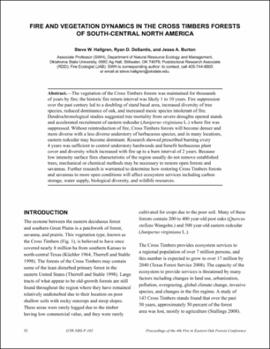| dc.contributor.author | Hallgren, Steve | |
| dc.contributor.author | Desantis, Ryan | |
| dc.contributor.author | Burton, Jesse | |
| dc.date.accessioned | 2022-08-23T16:06:01Z | |
| dc.date.available | 2022-08-23T16:06:01Z | |
| dc.date.issued | 2012 | |
| dc.identifier.citation | Hallgren, S., Desantis, R., BUrton, J. Fire and vegetation dynamics in the Cross Timbers forests of South-Central North America. Proceedings of the 4th Fire in Eastern Oak Forests Conference, (GTR-NRS-P-102). | |
| dc.identifier.uri | https://hdl.handle.net/11244/336490 | |
| dc.description.abstract | The vegetation of the Cross Timbers forests was maintained for thousands of years by fire; the historic fire return interval was likely 1 to 10 years. Fire suppression over the past century led to a doubling of stand basal area, increased diversity of tree species, reduced dominance of oak, and increased mesic species intolerant of fire. Dendrochronological studies suggested tree mortality from severe droughts opened stands and accelerated recruitment of eastern redcedar (Juniperus virginiana L.) where fire was suppressed. Without reintroduction of fire, Cross Timbers forests will become denser and more diverse with a less diverse understory of herbaceous species, and in many locations, eastern redcedar may become dominant. Research showed prescribed burning every 4 years was sufficient to control understory hardwoods and benefit herbaceous plant cover and diversity which increased with fire up to a burn interval of 2 years. Because low intensity surface fires characteristic of the region usually do not remove established trees, mechanical or chemical methods may be necessary to restore open forests and savannas. Further research is warranted to determine how restoring Cross Timbers forests and savannas to more open conditions will affect ecosystem services including carbon storage, water supply, biological diversity, and wildlife resources. | |
| dc.description.abstract | The vegetation of the Cross Timbers forests was maintained for thousands of years by fire; the historic fire return interval was likely 1 to 10 years. Fire suppression over the past century led to a doubling of stand basal area, increased diversity of tree species, reduced dominance of oak, and increased mesic species intolerant of fire. Dendrochronological studies suggested tree mortality from severe droughts opened stands and accelerated recruitment of eastern redcedar (Juniperus virginiana L.) where fire was suppressed. Without reintroduction of fire, Cross Timbers forests will become denser and more diverse with a less diverse understory of herbaceous species, and in many locations, eastern redcedar may become dominant. Research showed prescribed burning every 4 years was sufficient to control understory hardwoods and benefit herbaceous plant cover and diversity which increased with fire up to a burn interval of 2 years. Because low intensity surface fires characteristic of the region usually do not remove established trees, mechanical or chemical methods may be necessary to restore open forests and savannas. Further research is warranted to determine how restoring Cross Timbers forests and savannas to more open conditions will affect ecosystem services including carbon storage, water supply, biological diversity, and wildlife resources. | |
| dc.format | application/pdf | |
| dc.relation.ispartof | Proceedings of the 4th Fire in Eastern Oak Forests Conference, (GTR-NRS-P-102) | |
| dc.rights | This material has been previously published. In the Oklahoma State University Library's institutional repository this version is made available through the open access principles and the terms of agreement/consent between the author(s) and the publisher. The permission policy on the use, reproduction or distribution of the material falls under fair use for educational, scholarship, and research purposes. Contact Digital Resources and Discovery Services at lib-dls@okstate.edu or 405-744-9161 for further information. | |
| dc.title | Fire and vegetation dynamics in the cross timbers forests of south-central North America | |
| dc.date.updated | 2022-08-05T18:35:30Z | |
| dc.description.department | Natural Resource Ecology and Management | |
| dc.type.genre | Conference proceedings | |
| dc.type.material | Text | |
| dc.identifier.author | ScopusID: 35796894200 (Desantis, Ryan) | |
